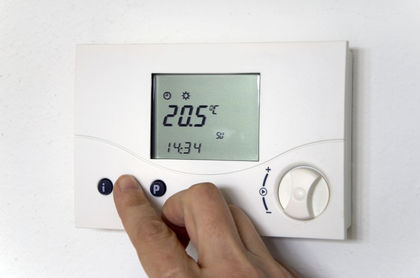Monday, 22/12/2025 | 09:01 GMT+7
Most people prefer an indoor temperature of 20 to 21°C to stay comfortable during the winter months. However, you may not need your home to be that warm when everyone is at work or school, and most people can sleep comfortably in cooler rooms.
A conventional thermostat regulates house heating at one temperature. Setting the temperature lower can save energy when you are out of the house or sleeping, but you may find the temperature uncomfortable while you wait for the house to heat up again.
Programmable thermostats offer a way to balance energy savings and comfort by giving you the option of changing the temperature setting automatically at night and when you have left the house. A programmable thermostat contains an electronic clock that you can program to allow the home’s temperature to drop during these times, saving you heating costs. Programming can also return the house to a more comfortable temperature just before you normally come home or wake up.
Programmable thermostats also allow you to automatically set the temperature higher over the summer months when you are out of the house for the day which can result in significant energy and cost savings – particularly in areas with time-of-use billing.

Research by the Canadian Centre for Housing Technology has shown that using a programmable thermostat can lead to energy savings of 5 to 15 per cent; the savings tend to be highest when the indoor-outdoor temperature difference is greatest during the winter months. It would be easy to conclude that the best strategy for saving on your utility bills is to turn the temperature as far down as possible, but that can create problems.
Most homeowners find that a temperature drop of 2°C leads to some savings at very little risk of moisture or comfort problems. If you keep an eye out for moisture and circulation issues, then programming your thermostat temperature setback is mostly a matter of finding a balance between your desire for energy savings, your level of comfort and avoiding moisture problems.
When programming your thermostat, keep in mind that the house does not heat up immediately: even if your furnace is able to heat the air quickly, the walls and floors remain cool, and they will cool the air between cycles. So it’s best to program the heat to turn back up before you get home or wake up. Some programmable thermostats have features that automatically “learn” the best time to start heating so temperatures are at a comfortable level when required.
Programmable thermostats work best for people who have predictable work and sleep periods, and adapting your thermostat’s program to your schedule can take some experimentation. If your schedule is completely irregular, your best strategy may be to make a habit of turning the thermostat down whenever you don’t need the heat.
The manual for your setback thermostat will tell you how to program it. Once you have your program in place, you won’t need to monitor it – and you will begin to enjoy energy savings right away.
Yen Pham








 Webinar 2: “Financial Support for Energy Efficiency Enterprises – Opportunities and Challenges”
Webinar 2: “Financial Support for Energy Efficiency Enterprises – Opportunities and Challenges”
 Vietnamese enterprises achieve green growth and cut costs through energy efficiency
Vietnamese enterprises achieve green growth and cut costs through energy efficiency
 Capacity Building for Program Implementing Entity
Capacity Building for Program Implementing Entity
 Enhance Energy Efficiency Knowledge for Managers of Cement Industrial Enterprises
Enhance Energy Efficiency Knowledge for Managers of Cement Industrial Enterprises
 Promoting Energy Efficiency for Technical Staff of Brick and Ceramic Sector
Promoting Energy Efficiency for Technical Staff of Brick and Ceramic Sector
 Capacity building for participating financial institutions of the VSUEE Project
Capacity building for participating financial institutions of the VSUEE Project
 Capacity building for participating financial institutions in Ho Chi Minh City
Capacity building for participating financial institutions in Ho Chi Minh City